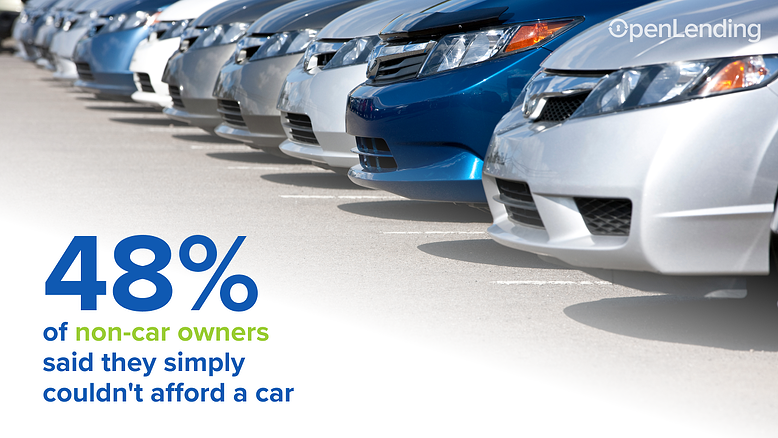3 Preliminary Findings From Our Recent Survey on Vehicle Accessibility




Nov 15, 2022
With COVID receding, more Americans are returning to physical working locations. But where does that leave lower-income individuals who can’t easily afford a car? How does vehicle ownership impact their careers? And what opportunity is there for financial institutions to challenge common consumer misconceptions about auto loan accessibility?
Open Lending can now answer these questions. We conducted a survey in September 2022 of 1,347 full- and part-time employees in the U.S., including 597 car owners and 750 non-car owners, all of whom know their FICO credit score. Of our respondents, 54% reported near and non-prime scores, while 25% reported prime scores. The goal of our survey was to better understand public sentiment around vehicle ownership and how it may influence lenders’ portfolio strategies and consumer sentiment around auto lending, especially when budgets are tight.
Now, our team is sharing some preliminary findings that we believe are particularly impactful, and on December 13th, we’ll reveal all research findings along with the release of an interactive microsite via a Webinar hosted by our VP of Marketing, Cody Gillund. Below is a small sample of what our analysis has uncovered.
💡 Sign up here to attend our Vehicle Accessibility webinar and to receive the full report in the form of an interactive eBook on December 13.
Cars are expensive — there’s no surprise there. But a shocking number of people across all income brackets feel that vehicle ownership is still too far out of reach. Some believe this so strongly, they aren’t even trying to apply for an auto loan.
Almost half (48%) of non-car owners said they simply couldn’t afford a car. Interestingly, this includes even people who sit well above the HHS Poverty Guidelines. To drill even deeper into that data point, nearly one-quarter of people making between $75K and $100K per year also say that car ownership remains just a pipe dream.
Meanwhile, a small but noticeable percentage of the population is actually disqualifying themselves from the lending process. Of non-car owners surveyed, 8% said they don’t feel they’d qualify for a car loan.
Younger generations feel this stretch even further, with 52% of 18- to 25-year-olds and 50% of 26- to 41-year-olds saying cars just aren’t affordable. While some of this might be expected for those who are less settled in their careers, it’s discouraging to see this issue still lingering among people who are well into their 30s and 40s.

Better career opportunities could close the affordability gap — but sadly, the American public is stuck in a Catch-22. Without access to a car, most people (55%) say they’ve had to turn down better job opportunities and promotions.
Meanwhile, 62% said a car would improve their job performance either moderately or significantly, and 64% said not having a car impacts their overall earning potential.
Non-car owners with lower credit scores are at an even greater disadvantage, saying they feel their earning potential has been negatively impacted. Lower-income respondents also reported having to turn down more job opportunities and promotions than higher-income respondents.
But it’s not just career advancement and earning potential at stake. Job satisfaction also takes a major hit: Car owners reported being more satisfied with their jobs (78%) than non-car owners (66%).
Non-car owners are also skeptical of the car-buying experience. In fact, one-quarter see the process as unclear and confusing. This challenge becomes even more pronounced when looking at individuals with lower credit scores, who tend to be much warier about what goes into buying a car.
To them, a good experience is a major factor. Among all non-car owners, 83% said they would return to a lender for other purposes if they felt the lender was transparent and straightforward — and there’s particular stickiness among people with lower credit scores. Still, just 11% of non-car owners find the car-buying experience (including applying for a loan) to be a clear and positive process.
In other words, when it comes to buying a car, all too many Americans are stuck in second gear — which is directly impacting their quality of life and livelihoods. For those with lower credit scores in particular, the correlation between a lack of vehicle access and professional/personal challenges is striking. From a lending perspective, there’s a clear and immediate opportunity to better serve consumers across credit segments, empowering near and non-prime borrowers with life-changing vehicle access.
So, how can lenders help close the auto loan accessibility gap? Open Lending will release a full report on the survey and announce findings, analysis, and expert advice via a webinar on Tuesday, December 13, at 12:00 p.m. CT. Sign up to receive the report and attend the webinar here.
Want to see what kind of growth your financial institution can expect using Open Lending’s Lenders Protection™ solution? Check out our Opportunity Calculator to see how your loan originations could increase.
ShareAll fields required
"*" indicates required fields